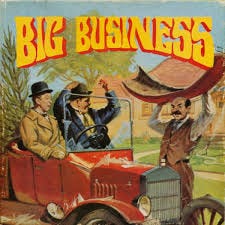The high falutin’ term we’ve been hearing for too long now is “retribution.” It sounds more technical and literary and high-level so that’s why the TV talking heads and the Republican Party toss it around so often. But really, we’re talking about something way more elemental — revenge. It’s one of the oldest traits we know of and also one of the saddest. It can never end.
In working with young writers in high school or even in college, one skill I always wanted them to learn was finding a way to make connections between seemingly unrelated things. A novel and a song. A poem and a painting. Or a silent comedy short and a quote from one of our most thoughtful writers.
Here was Kurt Vonnegut’s quote: “The whole idea of revenge was so important that Hammurabi, a great leader somewhere in the Middle East, wrote the Code of Hammurabi: an eye for an eye and a tooth for a tooth. Somebody pointed out this was in fact a peaceful proposal. He wasn't recommending that somebody take an eye for an eye or a tooth for a tooth. He was saying, "Take that much and no more." (Of course, that’s not how we read it today.)
“Then came this radical idea: If you ARE injured, don't avenge yourself. What kind of a person is that who doesn't seek revenge? Well, how’s this: “Forgive us our trespasses as we forgive those who trespass against us.” The Lord's Prayer, of course.”
We’d just had an issue of some girls fighting — avenging something someone had said, so there was a topical element to this assignment which I had planned to do anyway. I remembered reading Joseph Heller’s line about the writing of “Catch 22.” “I wanted to write something that would make them laugh, then look back in horror at what they were laughing at.”
That might have been a little stronger sentiment than what I was aiming for here. But I thought Vonnegut’s quote would plant a seed and a film would make a point. How to give my class an illustration of revenge? Why, Laurel & Hardy, of course.


And there was the laughter part. As a teacher, I always found it an amazing weapon when you could get your class laughing at something, then get them to think about what prompts the laughter. (The link to “Big Business” is attached below)
Another Laurel & Hardy short I used every year I wrote about earlier was their Academy Award-winning comedy short “The Music Box” where the two of them, rookie delivery boys, are well-intended but find innumerable ways of botching the delivery of a player piano to a professor whom they unwittingly — they did a lot of things unwittingly — insult on the delivery route up this enormous set of stairs.
It’s very funny and silly and when the film concluded and when the laughs died down, I asked them to think about what they saw and write: I helped with themes.
(A.) Do you see two long-time friends, certainly by now, used to each other’s screw-ups, trying their absolute darndest to accomplish their mission?
(B.) Do you see two men, bravely trying to do their best (which, granted, isn’t very good), even though it seems as though good fortune, fate, God or whoever is pulling the strings up there is against them at every turn?
(C.) Do you end up laughing about THEIR misfortune and screwups and stupid mistakes because IT’S NOT HAPPENING TO YOU? (The principle behind America’s Funniest Home Videos)
(D.) Do you see two guys who, in their actions, kind of show us that life is FULL of mistakes, goofs, bad choices and wrong turns. That – just like them – we can’t let these detours stop our progress. We have to get up, dust ourselves off and keep trying.
These were good questions, ones designed for them to learn critical thinking. Now if I’d have gone to Administration and explained what I was going to do, the idea of me using a silent comedy short from 1929 to make it work, I’m quite sure it would have been shot down. But keeping with a religious theme, better to ask forgiveness than permission, right?
Here was their assignment:
SYNTHESIS: Combining two (or more) genres into something unusual.
TODAY’S THEME: REVENGE:
Your assignment is three-fold.
· First, read Vonnegut’s comments on revenge.
· Second, watch Laurel and Hardy’s silent film “Big Business”
· Third, Write an essay on the concept of revenge, quoting Vonnegut and incorporating some of what you saw in the Laurel and Hardy film.
First:
WRITER KURT VONNEGUT talked about revenge here:
“The whole idea of revenge was so important that Hammurabi, a great leader somewhere in the Middle East, wrote the Code of Hammurabi: an eye for an eye and a tooth for a tooth. Somebody pointed out this was in fact a peaceful proposal. He wasn't recommending that somebody take an eye for an eye or a tooth for a tooth. He was saying, "Take that much and no more." (Of course, that’s not how we read it today.)
“Then came this radical idea: If you ARE injured, don't avenge yourself. What kind of a person is that who doesn't seek revenge? Well, how’s this: “Forgive us our trespasses as we forgive those who trespass against us.” The Lord's Prayer, of course.
WATCH LAUREL AND HARDY’s “Big Business” – (other actor is James Finlayson) You have about a half-hour to write an essay incorporating Vonnegut, Laurel and Hardy and the topic of revenge. Good luck!
Watch the 1929 film (with musical accompaniment) of Laurel & Hardy. (It’s funny)

